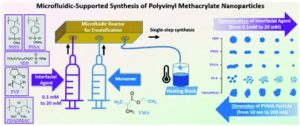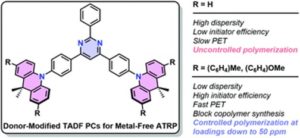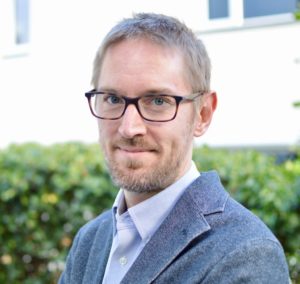| Julieta Paez is a group leader at the University of Twente in the Netherlands. Julieta obtained her PhD in Chemistry at the National University of Córdoba, Argentina, working with Prof. Miriam Strumia on the synthesis of polymeric materials for sensing and antifouling applications. After her PhD, Julieta moved to Prof. Rainer Haag’s lab at the Freie Universität Berlin, Germany, as a Postdoctoral Researcher, to investigate biofunctional polymeric-protein surfaces. She then joined the group of Prof. Aránzazu del Campo at the Max-Planck Institute for Polymer Research in Mainz, where she developed photoactivatable peptides for cell-instructive materials and also worked with catechol-functionalized polymers for tissue gluing applications. Next, she moved to INM – Leibniz Institute for New Materials in Saarbrücken, first as Research Scientist and then as Project Leader, developing novel coupling chemistries for bioconjugation and gelation under physiological conditions. Since April 2021, Julieta is Assistant Professor at the department of Developmental Bioengineering at the University of Twente. Her main interest is the development of chemical strategies to (macro)molecularly engineer smart hydrogels that interact with living cells and tissues, for healthcare applications.
Find out more about Julieta’s research here: https://www.researchgate.net/profile/Julieta_Paez2 You can follow Julieta on Twitter @PaezLab |
Read Julieta’s Open Access Emerging Investigator article, ‘Redox-triggerable firefly luciferin-bioinspired hydrogels as injectable and cell-encapsulating matrices’
Check out our interview with Julieta below:
1. How do you feel about Polymer Chemistry as a place to publish research on this topic?
Polymer Chemistry is a top reputed journal in the field, and represents a paramount home for discussion of the state-of-the-art. I feel delighted to contribute whenever is possible!
2. What aspect of your work are you most excited about at the moment and what do you find most challenging about your research?
I am thrilled about the transversal nature of my research. My work combines tools from synthetic organic and polymer chemistry, biomaterials science, and cell biology; to engineer smart soft materials that interacts with living cells and tissues. One research line in my lab is the development of responsive hydrogels for cell encapsulation. These artificial models can be used to study the complex communication between cells and between cells and their native microenvironment. The biggest challenge is that the native cell niche is very dynamic, therefore, capturing such features in a synthetic material is complex but fascinating at the same time.
3. In your opinion, what are the most important questions to be asked/answered in this field of research?
We want to better understand how cells communicate with themselves and with their environment, so we can develop novel approaches in tissue engineering and regenerative medicine. In this regard, engineered materials whose properties can be regulated on demand can help us to investigate those type of questions. I am particularly interested in the possibility of controlling matrix viscoelasticity on demand to steer cell behavior. Thereby, I believe that the polymer chemistry field has much to offer by providing inspiration towards novel mechanoresponsive polymeric tools upon which smart biomaterials can be built.
4. Can you share one piece of career-related advice or wisdom with other early career scientists?
I would encourage young researchers to get involved into (and, eventually, to create their own) diverse scientific teams. I have enjoyed very much my journey so far, since it allowed me to be surrounded and get inspired by researchers from diverse disciplines, career stage, geographical background and way of thinking. This multidisciplinary and multicultural ingredient of a scientific team, which has greatly impacted my career, is in my view what makes science very creative, rewarding and fun.





















